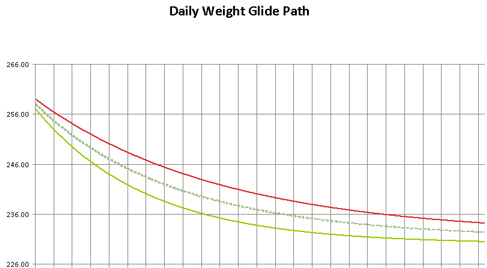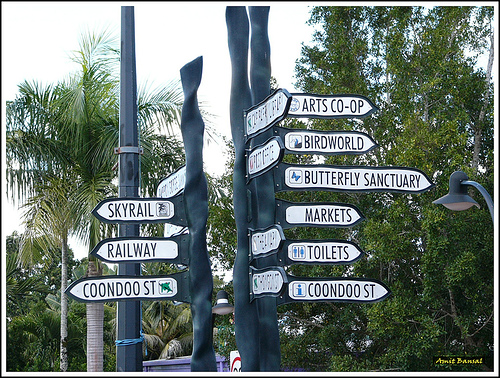I’m currently reading Tim Ferriss’ book The Four Hour Body, and while it’s too early for me to render any opinion on the book as a whole, he relates a true story that beautifully illustrates the power of simple awareness. It goes something like this:
Phil Libin, who weighed 258 pounds, wanted to get down to 230 pounds in six months–a weight loss goal of about a pound a week. However, he wasn’t enthusiastic about making any lifestyle changes, so he decided to try an experiment to see whether he could accomplish his goal by making just one change: becoming very aware of his weight.
Phil created a spreadsheet with a little graph showing his starting weight at one end and his goal weight at the other end, with a line between the two. Above and below the line he put boundary lines: the plan wasn’t for his weight to follow the line to the goal weight exactly, but to stay between the top and bottom boundary lines so that he would be assured he was proceeding in the right direction at about the right speed. The result looked something like this:
From there, all Phil did was track his weight from day to day and enter it into the spreadsheet. If his weight fell below the bottom line at any point (which did happen), he would eat more. If his weight went above the top line (which didn’t happen), he would eat less.
Weirdly, and importantly, Phil made no other attempt to change his behavior–quite the opposite. He didn’t exercise or try to change his eating habits or consciously do anything about his weight except monitor it. And as you can probably guess by now, he landed exactly where he intended to be at the end of the six months, weighing in at 230 pounds.
I don’t actually recommend Phil’s method on its own. You have to be a real data enthusiast to care so much about a graph that you will be sure to keep it up to date and be so interested in what it has to show you. Further, since there are some really easy things you can do to move toward a goal above and beyond just being aware of where you’re going, it seems wasteful to disregard these other options. At the same time, Phil’s experience, at least anecdotally, makes a strong case for awareness being not only an important prerequisite for other useful changes, but a force for change on its own. Also, it makes a good case for focus: if all you need to think about to achieve your goal is “stay between the lines,” then it’s pretty easy to stay mentally on task.
Ferriss offers a free Excel spreadsheet patterned after Phil’s that you can tailor to your own goals at www.fourhourbody.com/phil .
Other articles on this site that might interest you on the subject of awareness include











